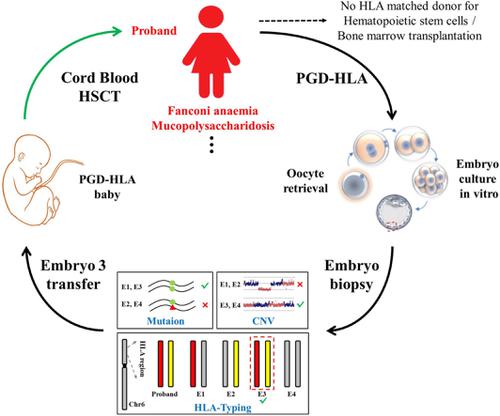当前位置:
X-MOL 学术
›
Clin. Genet.
›
论文详情
Our official English website, www.x-mol.net, welcomes your
feedback! (Note: you will need to create a separate account there.)
A strategy using SNP linkage analysis for monogenic diseases PGD combined with HLA typing.
Clinical Genetics ( IF 2.9 ) Pub Date : 2020-05-07 , DOI: 10.1111/cge.13770 Yuqian Wang 1, 2, 3 , Meng Qin 1, 2, 3 , Zhiqiang Yan 1, 2, 3 , Shuo Guan 1, 2, 3 , Ying Kuo 1, 2, 3 , Siming Kong 1, 2, 3 , Yanli Nie 1, 2, 3 , Xiaohui Zhu 1, 2, 3 , Xu Zhi 1, 2, 3 , Jie Qiao 1, 2, 3, 4, 5, 6 , Liying Yan 1, 2, 3
Clinical Genetics ( IF 2.9 ) Pub Date : 2020-05-07 , DOI: 10.1111/cge.13770 Yuqian Wang 1, 2, 3 , Meng Qin 1, 2, 3 , Zhiqiang Yan 1, 2, 3 , Shuo Guan 1, 2, 3 , Ying Kuo 1, 2, 3 , Siming Kong 1, 2, 3 , Yanli Nie 1, 2, 3 , Xiaohui Zhu 1, 2, 3 , Xu Zhi 1, 2, 3 , Jie Qiao 1, 2, 3, 4, 5, 6 , Liying Yan 1, 2, 3
Affiliation

|
Preimplantation genetic diagnosis (PGD) of genetic diseases, combined with human leukocyte antigen (HLA) typing (PGD‐HLA), is a useful technique to have healthy offspring that are compatible with a sibling for hematopoietic stem cells transplantation (HSCT) to treat their genetic diseases. Here, we report a new strategy using single nucleotide polymorphism (SNP) linkage analysis for monogenic disease PGD combined with HLA typing, to simultaneously obtain the information of chromosomal aneuploidy, target mutations and HLA typing through a single low‐depth next generation sequencing (NGS) procedure. In this study, five couples with probands underwent SNP linkage analysis for PGD‐HLA typing were recruited. Within these five couples, two couples fortunately harvested four unaffected and HLA matched embryos with their siblings. After embryo transfer, two healthy neonates were born successfully. Subsequently, cord blood hematopoietic stem cells obtained from these two neonates were collected and frozen for treating their sick siblings. This novel strategy could provide abundant and specific SNPs for each family, therefore linkage information adjacent and even within HLA clusters were apparent. This study offers a highly flexible and precise method which could eliminate misdiagnosis caused by chromosomal recombination of the HLA gene, thus potentially benefit the success rate of HSCT.
中文翻译:

使用SNP连锁分析对单基因疾病PGD结合HLA分型的策略。
遗传疾病的植入前遗传学诊断(PGD)与人类白细胞抗原(HLA)分型(PGD-HLA)结合使用是一种有用的技术,可使其健康的后代与同胞进行造血干细胞移植(HSCT)的治疗相适应遗传疾病。在这里,我们报道了一种使用单核苷酸多态性(SNP)连锁分析对单基因疾病PGD与HLA分型相结合的新策略,以通过单个低深度下一代测序(NGS)同时获得染色体非整倍性,靶标突变和HLA分型的信息)程序。在这项研究中,招募了五对先证者进行SGD连锁分析以进行PGD-HLA分型。在这五对夫妇中,两对夫妇幸运地收获了四个未受影响的且HLA与其兄弟姐妹匹配的胚胎。胚胎移植后 两个健康的新生儿成功出生。随后,收集从这两个新生儿获得的脐带血造血干细胞并冷冻以治疗其患病兄弟姐妹。这种新颖的策略可以为每个家庭提供丰富而特定的SNP,因此邻近甚至HLA簇内的连锁信息是显而易见的。这项研究提供了一种高度灵活和精确的方法,可以消除由HLA基因的染色体重组引起的误诊,从而潜在地提高HSCT的成功率。因此,在HLA群集附近甚至在HLA群集内的链接信息都是显而易见的。这项研究提供了一种高度灵活和精确的方法,可以消除由HLA基因的染色体重组引起的误诊,从而潜在地提高HSCT的成功率。因此,在HLA群集附近甚至在HLA群集内的链接信息都是显而易见的。这项研究提供了一种高度灵活和精确的方法,可以消除由HLA基因的染色体重组引起的误诊,从而潜在地提高HSCT的成功率。
更新日期:2020-07-15
中文翻译:

使用SNP连锁分析对单基因疾病PGD结合HLA分型的策略。
遗传疾病的植入前遗传学诊断(PGD)与人类白细胞抗原(HLA)分型(PGD-HLA)结合使用是一种有用的技术,可使其健康的后代与同胞进行造血干细胞移植(HSCT)的治疗相适应遗传疾病。在这里,我们报道了一种使用单核苷酸多态性(SNP)连锁分析对单基因疾病PGD与HLA分型相结合的新策略,以通过单个低深度下一代测序(NGS)同时获得染色体非整倍性,靶标突变和HLA分型的信息)程序。在这项研究中,招募了五对先证者进行SGD连锁分析以进行PGD-HLA分型。在这五对夫妇中,两对夫妇幸运地收获了四个未受影响的且HLA与其兄弟姐妹匹配的胚胎。胚胎移植后 两个健康的新生儿成功出生。随后,收集从这两个新生儿获得的脐带血造血干细胞并冷冻以治疗其患病兄弟姐妹。这种新颖的策略可以为每个家庭提供丰富而特定的SNP,因此邻近甚至HLA簇内的连锁信息是显而易见的。这项研究提供了一种高度灵活和精确的方法,可以消除由HLA基因的染色体重组引起的误诊,从而潜在地提高HSCT的成功率。因此,在HLA群集附近甚至在HLA群集内的链接信息都是显而易见的。这项研究提供了一种高度灵活和精确的方法,可以消除由HLA基因的染色体重组引起的误诊,从而潜在地提高HSCT的成功率。因此,在HLA群集附近甚至在HLA群集内的链接信息都是显而易见的。这项研究提供了一种高度灵活和精确的方法,可以消除由HLA基因的染色体重组引起的误诊,从而潜在地提高HSCT的成功率。











































 京公网安备 11010802027423号
京公网安备 11010802027423号